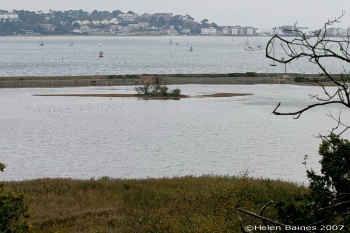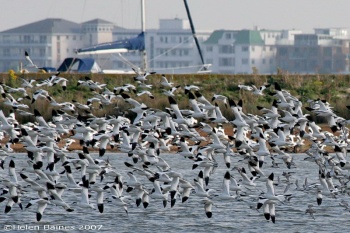Overview
Owned by the National Trust, Brownsea is the largest of the islands in Poole Harbour at 560 acres, and ornithologically the most important.
About 247 acres (100ha) of the northern part of the island is managed as a nature reserve and includes a large brackish lagoon and freshwater ponds, reedswamp and saltmarsh. Elsewhere on the island there are coniferous and mixed woodlands interspersed with open grassed areas, heather and rhododendron scrub.
More than 200 species have been recorded on the island with over 60 breeding species.
Birds
Notable Species
The lagoon in the north-east is the most interesting part of the island from a birding point of view. Sandwich Tern and Common Tern nest on the lagoon as well as gulls, Common Shelduck, Oystercatcher and Water Rail.
Breeding passerines include Reed Warbler, Sedge Warbler and Reed Bunting. Little Grebe breed on the freshwater ponds. Elsewhere on the island there are other interesting breeding species including Woodcock, European Nightjar and Wood Warbler and there is a small, and often elusive, population of Golden Pheasant.
Passage periods bring a wide range of waders to Brownsea including Spotted Redshank and Greenshank, Little Stint and Ruff. One or two Ospreys pass over each year, Black Tern and Little Gull are often present in autumn, Little Egret is now regular and Eurasian Spoonbill is a fairly frequent visitor.
Passerine migrants include the usual chats, flycatchers and warblers. Rarities such as American Wigeon, Black-winged Stilt and Terek Sandpiper have been recorded on Brownsea.
In winter the island is famous for its regular flock of Pied Avocet but other waders occur in good numbers notably Red Knot, godwits and Spotted Redshank often winters here. Common Kingfisher and Rock Pipit are regular on the lagoon, and in more recent years Spoonbill.
Duck occur on the ponds and lagoon and offshore in Poole Harbour and include Northern Pintail, Common Goldeneye and Red-breasted Merganser.
Check-list
Birds you can see here include:
Little Grebe, Great Crested Grebe, Great Cormorant, Little Egret, Grey Heron, Eurasian Spoonbill, Canada Goose, Dark-bellied Brent Goose, Common Shelduck, Eurasian Wigeon, Gadwall, Common Teal, Mallard, Northern Pintail, Northern Shoveler, (rare Su), Common Pochard, Tufted Duck, Common Goldeneye, Red-breasted Merganser, Eurasian Sparrowhawk, Northern Hobby, Merlin, Peregrine Falcon, Osprey, Golden Pheasant, Water Rail, Common Moorhen, Common Coot, Eurasian Oystercatcher, Pied Avocet, Common Ringed Plover, Grey Plover, Red Knot, Sanderling, Little Stint, Curlew Sandpiper, Dunlin, Ruff, Common Snipe, Eurasian Woodcock, Black-tailed Godwit, Bar-tailed Godwit, Whimbrel, Eurasian Curlew, Spotted Redshank, Common Redshank, Common Greenshank, Green Sandpiper, Wood Sandpiper, Common Sandpiper, Little Gull, Black-headed Gull, Lesser Black-backed Gull, European Herring Gull, Great Black-backed Gull, Sandwich Tern, Common Tern, Little Tern, Black Tern, Eurasian Nightjar, Common Kingfisher, Eurasian Green Woodpecker, Great Spotted Woodpecker, Rock Pipit, Common Wren, Dunnock, European Robin, Whinchat, European Stonechat, Eurasian Blackbird, Song Thrush, Sedge Warbler, Common Reed Warbler, Wood Warbler, Common Chiffchaff, (rare W), Willow Warbler, Goldcrest, Spotted Flycatcher, European Pied Flycatcher, Coal Tit, Blue Tit, Great Tit, Eurasian Nuthatch, Eurasian Treecreeper, Chaffinch, European Greenfinch, Eurasian Siskin, Lesser Redpoll, Reed Bunting
Other Wildlife
In addition to birds, the island is well-known as one of the few areas of southern Britain to support Red Squirrel. Sika Deer are also present. Butterflies are well-represented and twenty-three species of dragonfly have been recorded.
Site Information
History and Use
In 1907, Robert Baden-Powell held his first boys' camping event, which was in fact the world's first Boy Scout camp. He choose to hold the camping event on the island to test his ideas for a book on Scouting for Boys. Boys camping events continued on Brownsea up until the 1930s and a Scouting centenary event was held in 2007. The British Government turned over the ownership of the Island to the National Trust in 1962 and it was opened to the public in 1963.
Areas of Interest
The Dorset Wildlife Trust's Nature Reserve with its lagoon and 5 hides.
Access and Facilities
The island is open to the general public from late March to early November, 10am - 5pm, and the reserve is open for self-guided nature trails from 10.30am - 4.30pm. Enter the reserve entrance near the church and collect a leaflet. The Dorset Wildlife Trust arranges guided tours in July and August daily from 2pm - 3.45pm starting from the public hide. Groups of more than ten should book in advance and it is possible for Dorset Wildlife Trust members to visit the island out of season. For full details of these trips and also ferries, fees etc, visit Dorset Wildlife Trust and National Trust - Brownsea Island.
There are hides overlooking the best areas of the reserve but there is also much to see on the rest of the island. Boats to the island operate every half-hour from 10.00 - 4.30pm (5.30pm in high season) from Sandbanks Ferry and Poole Quay. Poole and the surrounding area have plentiful hotel, guest-house and campsite accommodation.
There is a visitor centre and museum, plus a shop and cafe.
Contact Details
Brownsea Island
Poole Harbour
Dorset BH13 7EE
01202 707744 (General enquiries)
01202 701635 (Fax)
- Email: brownseaisland@nationaltrust.org.uk
- List of references
Recommended Citation
- BirdForum Opus contributors. (2025) Brownsea Island. In: BirdForum, the forum for wild birds and birding. Retrieved 11 May 2025 from https://www.birdforum.net/opus/Brownsea_Island
External Links
- Brownsea Island
- BIRDGUIDES website for Brownsea Island
- Information on the National Trust website
- Brownsea Island on Streetmap
GSearch checked for 2020 platform.1
Content originally posted by Steve
Reviews
teamsaint's review A stunning island with lots of birds. Lots of different habitats mean that you can see lots of different birds. Having a telescope is useful when looking over the lagoon as it is a large area and the 3 hides are all on one side. Pros
- Nice place. Lots of birds. Helpful staff.
Cons
- Only open April-October. Lots of extra charges eg. boat
- landing fee
- entry to Dorset wildlife part of reserve
- entry to the Lodge.






